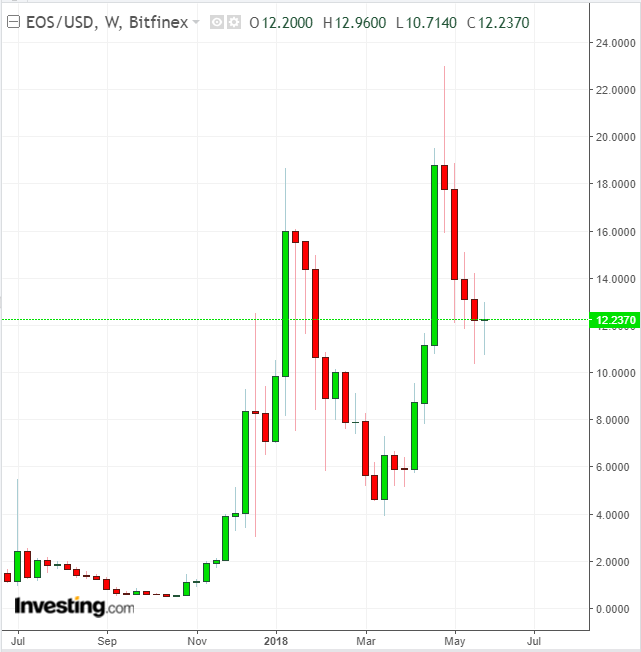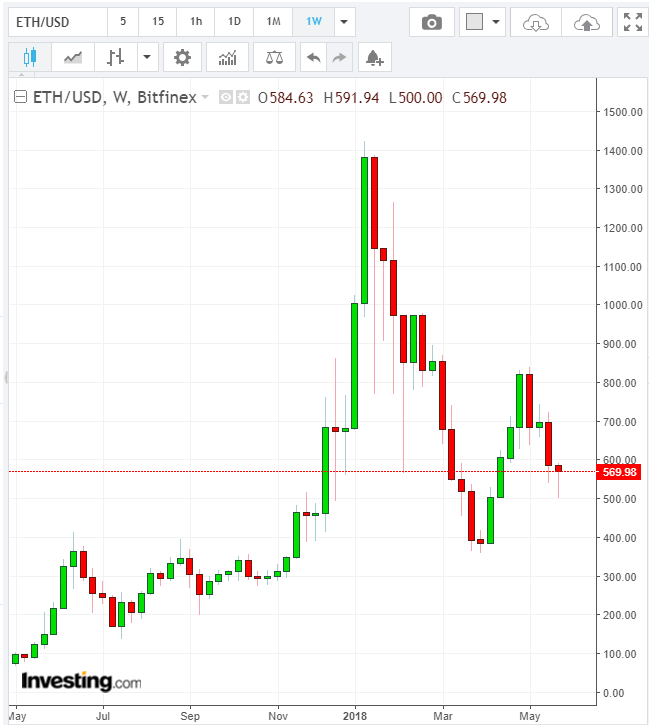EOS, the fifth largest cryptocurrency by market cap right now, is gearing up to enter a new, highly anticipated phase in just a few days. Specifically, the alt-currency, which today exists on the Ethereum blockchain as ERC-20 tokens, will be moved to its own mainnet, or main network.
This mainnet launch, which many believe has the capability of boosting EOS's value significantly, is scheduled for June 2, this coming Saturday. In anticipation, the digital currency rallied nearly 500 percent, but on April 29, when news broke that problems could hamper the move, EOS slumped.

Indeed, there have been a number of claims online about security flaws and other vulnerabilities detected on the new EOS platform. The developers behind the upcoming distribution took to Twitter to deny rumors:
“Media has incorrectly reported a potential delay in the release of EOSIO V1 due to software vulnerabilities. Our team has already fixed most and is hard at work with the remaining ones. EOSIO V1 is on schedule; please stay tuned to our EOSIO channels for official information.”
Notwithstanding the developer response—and attendant fixes—it appears investors aren't rushing back, but rather waiting to see what happens next.
For background, EOS was created by Block.one, a Cayman Islands-based company and released mid-2017. The project is headed by Dan Larimer who is also the founder of Steem, an alt-coin that powers the social media platform Steemit, and Bitshares, a decentralized platform for cryptocurrency trading. There were some who thought this alt-coin, which aims to be faster and more scalable than Ethereum, could one day overtake the second most popular cryptocurrency by market cap.
Does this recent uncertainty about the efficacy and possible scheduling of the mainnet launch undermine EOS's future value proposition?
Yo Kwon, CEO and co-founder, Hosho says even though developers have made every effort to make the transition straightforward, this is still quite a serious change. Not only is EOS already one of the largest cryptocurrencies by market cap, but every owner has to potentially go through registration or use a new wallet to ensure they can claim their EOS coins after the launch.
He notes that security will be the largest concern once the mainnet launch occurs. Since up until recently the testnet (test network) has been undergoing rapid changes, there are still a number of bugs being discovered. It's Yo's view that EOS needs to engage with a number of third party cybersecurity firms to conduct a full audit before release of the mainnet platform and environment for running smart contracts. This would, of course, necessitate a longer period of time for the bug bounty to occur.
Greatest Obstacle Might Not Be Mainnet Issues
But the general consensus surrounding EOS's transformation and how that might drive the value of this particular asset actually has as much to do with Ethereum (ETH) as with EOS's upcoming mainnet launch. Ethereum was recently hit by a vicious selloff that at one point this past Sunday into Monday saw the digital currency's price fall as much as 14% within one hour.

Many are blaming the volatility and attendant collapse of ETH on EOS dumping the ETH platform.
As we've previously discussed, EOS has been dubbed a direct competitor to Ethereum, even though ETH is very well funded and backed by big names in both the crypto and real-world tech industry. Samuel Brooks, the lead blockchain architect for energy startup Enosi points out that ultimately, Ethereum still enjoys a huge lead over EOS in terms of maturity, ecosystem tools and developer mindshare, but these facts probably won't stop the EOS hype train from gaining lots of attention—at least temporarily.
Brooks explains that, to a significant degree, most cryptocurrencies are still held for their speculative value, meaning many investors flock to different coins independent of their real value. Unfortunately, this often leads to volatility based on which technology is the most ‘fashionable’.
“While EOS is said to be "faster" than Ethereum, its consensus mechanism is also technically less secure. Ethereum is also developing scalability techniques that will see it operate "faster" than EOS before the end of the year. There's always a trade-off between 'trust' and 'performance.' Clearly there's a long way to go for both platforms, but developers with real-world applications will be wary of releasing production code on EOS until it's more mature.”
It's a big step for the project and the ecosystem says Charles Manning, CEO of XCHNG, but EOS has yet to prove itself in terms of real-life scalability, security, reliability and adoption.
“They are less than a week away from the launch of their Mainnet and still going through some major fixes, as reported by Qihoo 360 as of 5/29/18. Once all code is executed correctly and adoption occurs, this is a platform that will be a direct competitor with other smart contract capable blockchains.”
That's where the belief that EOS could cause the price of EOS to crash comes from. Brooks disagrees: "EOS should not cause the Ethereum price to crash because it has yet to work through many maturity challenges that Ethereum has already overcome."
Ethereum Still King
Many agree that Ethereum will remain the king of smart contracts for quite some time. Elliot Rothfield, co-founder and creative director of WatermelonBlock believes that any experienced trader will agree, in this highly speculative sector of the market the key is to buy the rumor and sell the news.
“We have been watching the global sentiment surrounding EOS. Although it’s quite positive right now, it’s not even close to contending with Ethereum’s 57 billion dollar market cap. EOS is a great project, but I would be very wary of a mainnet launch sell off. Don’t get caught at the top!”
